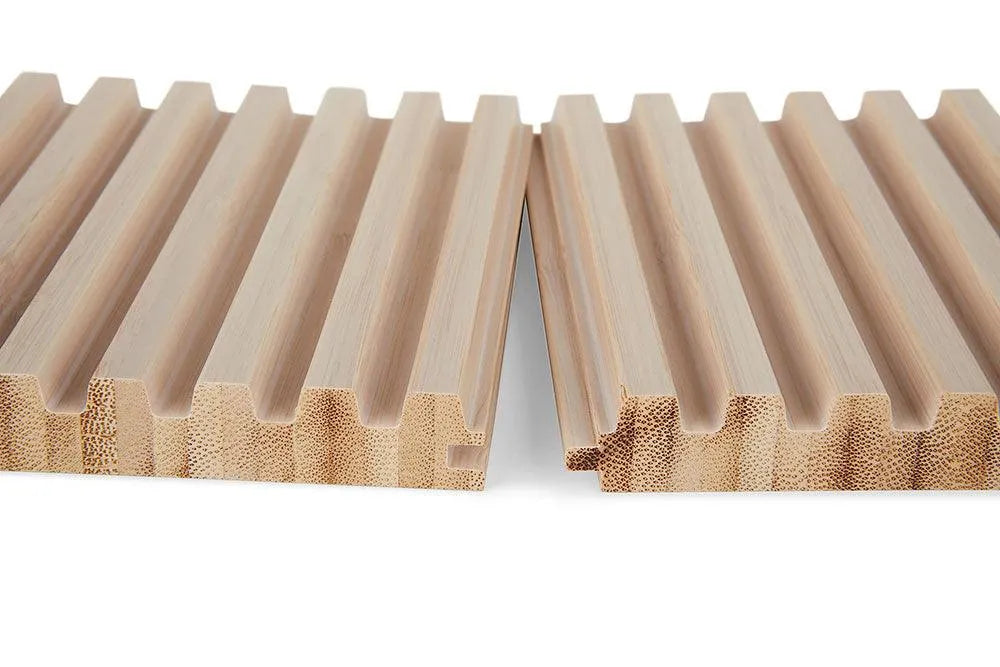Bamboo is increasingly used in Australian interiors, but not all bamboo wall panels perform the same. Differences in construction, durability, and application suitability can lead to poor outcomes if misunderstood. We break down the main types of bamboo panels used for internal cladding — and what professionals need to know before specifying them.
1. Strand Woven Bamboo
Structure: Made by compressing shredded bamboo fibres with resin under high pressure. This procedure creates a dense, hard board that resembles timber more than traditional bamboo.
Applications: Ideal for high-traffic surface areas, commercial fitouts, and joinery where strength is critical.
Pros:
- Extremely durable — harder than most hardwoods
- Often available pre-finished in natural or carbonised tones
- Low expansion/contraction when properly acclimatised
Cons:
- Heavier than other bamboo panels
- Harder to cut and machine — can wear down blades quickly
- Less “bamboo-like” in appearance
2. Laminated Bamboo Wall Panels
Structure: Laminated panels are made from strips of bamboo glued together either horizontally (flat grain) or vertically (edge grain), often with multiple layers cross-laminated for extra stability.
Applications: These are typically used in wall linings, cabinetry, and ceiling applications.
Pros:
- Visibly “natural” bamboo grain
- Readily available in multiple thicknesses (usually 10–40 mm)
- Stable in dry environments
Cons:
- Susceptible to shrinkage/expansion if not properly sealed
- Some adhesives may emit VOCs — check for E0/E1 certifications
- Flat grain versions can dent easily under pressure
3. Bamboo Veneer on Substrate (e.g., Plywood or MDF)
Structure: A thin bamboo veneers (typically 0.6–2 mm) applied to a substrate like MDF or plywood.
Applications: Cost-effective cladding for decorative wood paneling for walls or cabinet surfaces not exposed to heavy wear.
Pros:
- Reasonably lightweight and flexible
- Smooth, uniform appearance
- Easy to apply using conventional woodworking tools
Cons:
- Limited durability — easily dented or delaminated under impact
- Performance highly dependent on substrate quality and adhesive
- May not be suitable for wet or high-humidity zones
4. Engineered Bamboo Wall Panels (Cross-Ply or Multi-Layered)
Structure: These panels combine multiple layers of bamboo, often with alternating grain directions, for structural rigidity and warp resistance.
Applications: High-end joinery, premium cladding, custom acoustic panels.
Pros:
- Excellent stability in changing humidity conditions
- Can be machined or profiled into complex shapes
- Consistent visual quality with architectural-grade finishes
Cons:
- Higher cost
- Lead times may be longer due to manufacturing complexity
5. Woven or Fabric-Laminated Bamboo Panels
Structure: Made from woven bamboo strips or thin slats laminated onto flexible backers like fabric or paper, allowing for curved or feature surfaces.
Applications: Decorative rangehood covers, ceiling inlays, column wraps,, and curved joinery elements.
Pros:
- Ultra-flexible and visually striking
- Great for decorative use where standard boards are too rigid
- Reasonably lightweight and easy to install
Cons:
- Not suitable for structural or high-impact surfaces
- Requires careful adhesive selection to avoid bubbling or lifting
- Finishing/sealing options can be limited




